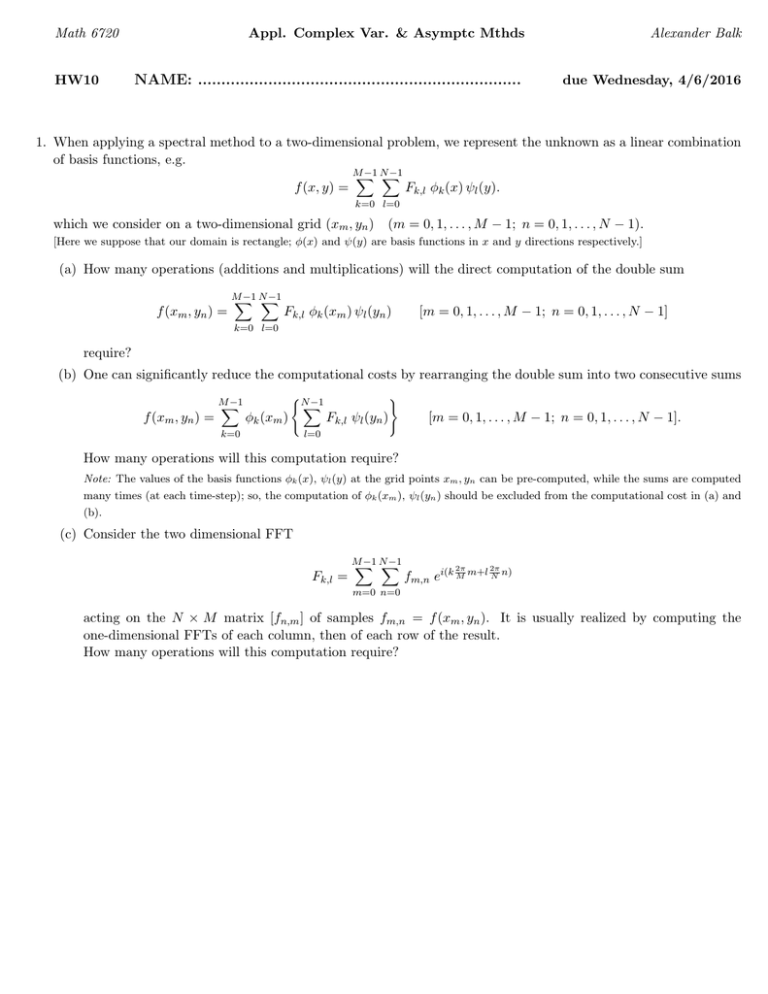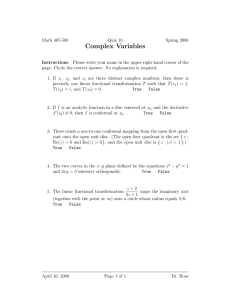NAME: .....................................................................
advertisement

Math 6720
HW10
Appl. Complex Var. & Asymptc Mthds
Alexander Balk
NAME: .....................................................................
due Wednesday, 4/6/2016
1. When applying a spectral method to a two-dimensional problem, we represent the unknown as a linear combination
of basis functions, e.g.
f (x, y) =
M
−1 N
−1
X
X
Fk,l φk (x) ψl (y).
k=0 l=0
which we consider on a two-dimensional grid (xm , yn )
(m = 0, 1, . . . , M − 1; n = 0, 1, . . . , N − 1).
[Here we suppose that our domain is rectangle; φ(x) and ψ(y) are basis functions in x and y directions respectively.]
(a) How many operations (additions and multiplications) will the direct computation of the double sum
f (xm , yn ) =
M
−1 N
−1
X
X
Fk,l φk (xm ) ψl (yn )
[m = 0, 1, . . . , M − 1; n = 0, 1, . . . , N − 1]
k=0 l=0
require?
(b) One can significantly reduce the computational costs by rearranging the double sum into two consecutive sums
f (xm , yn ) =
M
−1
X
φk (xm )
(N −1
X
k=0
)
Fk,l ψl (yn )
[m = 0, 1, . . . , M − 1; n = 0, 1, . . . , N − 1].
l=0
How many operations will this computation require?
Note: The values of the basis functions φk (x), ψl (y) at the grid points xm , yn can be pre-computed, while the sums are computed
many times (at each time-step); so, the computation of φk (xm ), ψl (yn ) should be excluded from the computational cost in (a) and
(b).
(c) Consider the two dimensional FFT
Fk,l =
M
−1 N
−1
X
X
2π
2π
fm,n ei(k M m+l N n)
m=0 n=0
acting on the N × M matrix [fn,m ] of samples fm,n = f (xm , yn ). It is usually realized by computing the
one-dimensional FFTs of each column, then of each row of the result.
How many operations will this computation require?
2. Computer simulation of non-linear PDEs.
As an example, consider PDE
∂
(∆ψ − ψ) + ψx + ψx ∆ψy − ψy ∆ψx = 0.
∂t
Several essentially different physical problems — the dynamics of atmosphere and ocean, nuclear fusion with magnetic confinement,
magnetohydrodynamics of Earth’s liquid iron core — lead to this equation.
To simulate this equation numerically, we consider it in a box (0 ≤ x ≤ Lx , 0 ≤ y ≤ Ly with periodic boundary
conditions), represent the unknown function as superposition of Fourier harmonics
ψ(x, y, t) =
Mx
X
My
X
2π
2π
i(k L
x+l L
y)
ψk,l (t) e
x
y
,
k=−Mx l=−My
and reduce our PDE to a system of ODEs for the Fourier coefficients ψk,l (t). We then integrate this system in time
t using the standard ODE solver, e.g. Runge-Kutta method.
(a) Write out the ODE system.
(b) How would you compute the nonlinear terms? The goal is speed, avoiding “aliasing”.
3. Prove the Schwartz Lemma: Let f (z) be
• analytic in U = {z : |z| < 1},
• |f (z)| ≤ 1 in U ,
• f (0) = 0.
Then |f (z)| ≤ |z| in U .
Suggestion: Consider function h(z) =
f (z)
.
z
Show that it is analytic in U (the singularity at z = 0 can be removed).
Take an arbitrary ρ ∈ (0, 1). Apply the maximum principle to h(z) to show that |h(z)| ≤ 1/ρ when z is in the disc Uρ = {z : |z| ≤ ρ}.
Finally, take the limit as ρ → 1. Why do you need to consider a smaller disc Uρ ⊂ U ?
4. Show that a 1-to-1 conformal map of a disc onto a disc is necessarily bilinear.
Suggestion: Consider an arbitrary disc in the ζ-plane and another arbitrary disc in the ω-plane. Riemann says that there is a 1-to-1
conformal transformation of the first disc onto the second one; you need to show that this conformal map is bilinear. Follow these steps:
(a) Some point ζ0 of the first disc is taken to some ω0 of the second disc.
There is a bilinear transformation ζ → ζ̃ of the ζ-plane disc onto the unit disc {|ζ̃| < 1} (HW9). Herewith ζ0 is taken to some ζ̃0 .
Similar, there is a bilinear transformation ω → ω̃ of the ω-plane disc onto the unit disc {|ω̃| < 1}. Herewith ω0 is taken to some ω̃0 .
(b) Find the bilinear transformation that maps {|ζ̃| < 1} onto the unit disc U z = {|z| < 1} and takes ζ̃0 to the origin.
Similar, find the bilinear transformation that maps {|ω̃| < 1} onto U w = {|w| < 1} and takes ω̃0 to the origin.
(c) Use the Schwartz lemma to show that if a conformal transformation w = f (z) maps U z onto U w so that the origin of z-plane is
taken to the origin of the w-plane, then f (z) = eiβ z (β is a real number).
Indeed,
to the Schwartz lemma, |w| ≤ |z|. The Schwartz lemma for the inverse transformation z = g(w) says |z| ≤ |w|.
according
= 1 for all z ∈ U z . If the absolute value of an analytic function is constant, then the function is a constant (HW4).
So, f (z)
z
(d) Use the group property (HW9) to show that the original transformation of the ζ-plane disc onto the ω-plane disc is bilinear.
5. Solve Laplace’s equation
φxx + φyy = 0
in the domain between two circles
2
2
x +y =1
&
2
2
(x − 1) + y =
2
5
2
subject to the boundary condition
2
2
φ(x, y) = a when x + y = 1
and
2
2
φ(x, y) = b when (x − 1) + y =
2
5
2
(a and b are real parameters).
Suggestion: Conformally transform the domain between the two non-concentric circles onto a domain between concentric circles and use
new symmetry to reduce the PDE to an ODE.
Such transformation is necessarily bilinear; the map
z−m
1 − m̄z
maps the unit disc to itself. We can use the three parameters m and β to map the external circle into some circle with its center at the
ζ = eiβ
origin and some radius R (undetermined constant). We can take β = 0 and real m, so that we have a single real parameter; we find m
solving a certain quadratic equation.





